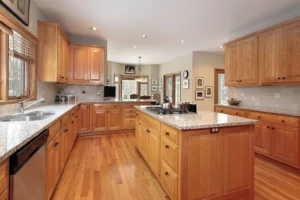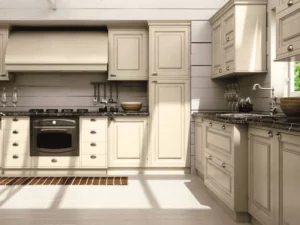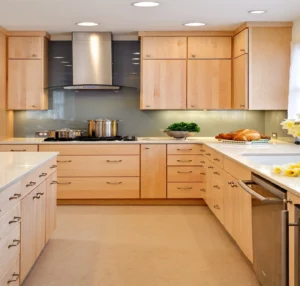Revamping your kitchen cabinets within a limited budget is feasible. However, it is crucial to exercise caution to avoid squandering funds or falling prey to deceptive cost-saving tactics without thorough planning. Consider that an inexperienced installer mar the aesthetics of your newly updated kitchen and potentially incur additional expenses. Even a lavishly invested dream kitchen can become a source of disappointment if entrusted to an unsuitable person for installation. The selection of kitchen cabinets is influenced by various factors, including the sourcing location, the materials used, geographical location, the number of cabinets required, the kitchen’s size, and whether professional assistance is sought. This list is not comprehensive enough, so let us delve deeper into these considerations.
Read more about cabinet types
Factors
Several factors can contribute to lower prices and make certain kitchen cabinets more affordable. The most determining key factors are represented below:
Material
The choice of material for kitchen cabinets can significantly impact their price. Here are some common materials used in kitchen cabinets and how they relate to affordability:

- Solid Wood: Solid wood, such as oak, maple, or cherry, is considered a high-end and durable material for cabinets. However, it tends to be more expensive than other materials due to its natural beauty and longevity.
- Plywood: Plywood is made by layering thin sheets of wood, creating a strong and stable material for cabinets. It is often more affordable than solid wood while providing good quality and durability.
- Medium Density Fiberboard (MDF): MDF is an engineered wood product that combines wood fibers with resin. It costs less than solid wood but offers good strength and stability. MDF cabinets are often covered with a veneer or laminate for an attractive finish.
- Particleboard: Particleboard is made from compressed wood particles bonded together with resin. It is the most affordable option but may need to be more durable than other materials. Particleboard cabinets are typically covered with a laminate or veneer.
- Thermofoil: Thermofoil cabinets consist of a substrate (often MDF or particleboard) covered with a thin layer of heat-sealed vinyl material. Thermofoil cabinets are generally less expensive and offer a smooth and easy-to-clean surface.
The choice of material depends on your budget, desired aesthetics, and durability requirements. While solid wood may be more expensive, cost-effective alternatives like plywood or MDF offer good quality and value for money.
Construction Method
The construction method used for the cabinets can affect their price. Cabinets with simpler construction, such as flat-pack or ready-to-assemble (RTA) cabinets, are generally more affordable than custom-built or fully assembled cabinets. So now that we know the construction method used for kitchen cabinets can have a significant impact on their price, here are a few construction methods and how they relate to affordability:
- Pre-fabricated or Stock Cabinets: Stock cabinets are pre-constructed in standard sizes and designs, making them more affordable than custom-built cabinets. They are mass-produced and readily available, which helps reduce costs.
- Ready-to-Assemble (RTA) Cabinets: RTA cabinets come in flat packs and require assembly. They are typically more affordable than pre-assembled cabinets since you are responsible for the assembly, eliminating labor costs.
- Custom-Built Cabinets: Custom-built cabinets are tailored to specific measurements, designs, and preferences. They are generally the most expensive option since they involve detailed craftsmanship and personalized features.
- Semi-Custom Cabinets: Semi-custom cabinets offer a middle ground between stock and custom cabinets. They allow for some customization while still being more affordable than fully custom-built options.
Choosing a construction method that aligns with your budget can help you find more cost-effective kitchen cabinets. However, it’s important to consider factors such as quality, durability, and design flexibility.
Cabinet Style
Cabinet styles often come at a higher price due to the additional craftsmanship and detailing. Choosing simpler and more streamlined cabinet styles can be a cost-effective option.
The style of kitchen cabinets can influence their pricing. Here are a few cabinet styles and how they relate to affordability:
- Shaker Style: Shaker cabinets feature clean lines, simplicity, and a timeless design. They are often more affordable than elaborate or ornate cabinet styles because of their straightforward construction.

- Flat Panel or Slab Style: Flat panel or slab cabinets have a flat, smooth surface without any raised or recessed features. This minimalist style is usually more budget-friendly due to its simplicity.
- Raised Panel: Raised panel cabinets have a center panel above the surrounding frame. This style often includes more intricate details and craftsmanship, making it slightly more expensive than flat panel cabinets.
- Glass Front or Open Cabinets: Glass front or open cabinets have doors with glass inserts or no doors. While the price can vary depending on the materials used, this style generally requires precision in construction, potentially impacting the cost.
- Custom or Specialty Styles: Custom or specialty cabinet styles with unique designs, decorative elements, or specialized finishes are more expensive. These styles often require additional craftsmanship and customization.
When considering cabinet styles, balancing your budget and desired aesthetic is important. Opting for simpler and more streamlined styles like shaker or flat panel cabinets can help keep costs more affordable while achieving a stylish and functional kitchen.
Cabinet Finish
The type of finish applied to the cabinets can impact their price. Custom finishes or specialized techniques may increase the cost, while standard or basic finishes are usually more affordable. Here are some common cabinet finishes and their relation to affordability:
- Laminate: Laminate finishes are made of a thin layer of synthetic material bonded to a substrate. Laminate is typically the most affordable option for cabinet finishes. It comes in various colors, patterns, and textures, allowing for versatile design choices.

- Thermofoil: Thermofoil is a vinyl material that is heat-sealed onto a substrate. Thermofoil finishes are often more cost-effective compared to other options. They offer a smooth and easy-to-clean surface but may be prone to damage from excessive heat.
- Painted: Painted finishes involve applying paint to the cabinet surface. While the cost can vary based on the quality and type of paint used, painted cabinets generally fall within a moderate price range. They offer various color options and can be easily refreshed or repainted in the future.
- Stained: Stained finishes involve applying a stain to enhance the wood’s natural grain. Stained cabinets can range in price depending on the type of wood and the complexity of the staining process. They provide a warm and traditional look, but customization options may be limited.
- Veneer: Veneer finishes involve applying a thin layer of real wood veneer to the cabinet surface. Veneer cabinets offer the look and feel of solid wood at a more affordable price. They come in various wood species and can be stained or painted for customization.
Remember that the quality and durability of the cabinet finish are important factors to consider. While some finishes may be more affordable, they may also require more maintenance or have a shorter lifespan. Balancing affordability with the desired aesthetic and long-term durability is key when choosing a cabinet finish.
Brand and Supplier
Different brands and suppliers offer cabinets at varying prices. Shopping around and comparing prices from different sources can help identify more affordable options.
Size and Configuration
The size and configuration of the cabinets needed for your kitchen also affect the overall cost. Larger kitchens or layouts that require a higher number of cabinets will naturally incur higher expenses. Here’s how size and configuration relate to affordability:
- Cabinet Size: Larger cabinets typically cost more than smaller ones due to the additional materials required for construction. Cabinets with more drawers, shelves, or specialized storage features may also come at a higher price.
Learn more about small kitchen cabinets
- Number of Cabinets: The total number of cabinets needed for your kitchen will impact the overall cost. The more cabinets are required, the higher the overall cost will be. Consider optimizing storage space by carefully planning the number and size of cabinets needed to avoid unnecessary expenses.
- Customization and Accessories: Cabinets with customized features, such as built-in organizers, pull-out shelves, or specialized hardware, often come at a higher price. Adding accessories and customization can increase the cost of cabinets.
- Layout and Configuration: The configuration of your kitchen cabinets can affect their pricing. Non-standard configurations or complex layouts may require custom cabinets, which are more expensive than standard options. Opting for simpler and more standard configurations can help keep costs down.
Carefully considering your storage needs and kitchen layout to determine the required size and configuration of cabinets is important. Balancing functionality, aesthetics, and budget will help you find the right combination of size and configuration while keeping costs within your desired range.
DIY vs. Professional Installation
Opting for DIY installation can save labor costs, making the cabinets more budget-friendly. However, if professional installation is necessary, it’s important to consider the associated installation costs.
Meanwhile, affordability is a key consideration when selecting kitchen cabinets; ensuring quality, durability, and functionality are paramount.
KEYWORDS:
